Higher Wind: Highlighted Expansion Opportunities to Repower Wind Energy
Abstract
:1. Introduction
2. Materials and Methods
3. Results
3.1. Wind Equipment Inventory
3.2. Suitability-Age Analysis
3.3. Wind Technology Assessment
3.4. Assessment of Wind Resource
3.5. Assessment of Transmission and Transportation Infrastructure
4. Discussion
5. Conclusions
Funding
Institutional Review Board Statement
Informed Consent Statement
Data Availability Statement
Acknowledgments
Conflicts of Interest
Abbreviations
| CapEx | Capital Expenditure |
| CF | Capacity factor |
| CREZs | Competitive Renewable Energy Zones |
| EHV | Extra-high-voltage transmission lines |
| ERCOT | Electric Reliability Council of Texas |
| NPC | Name Plate Capacity |
| USWTDB | U.S. Wind Turbine Database |
| WRF | Weather Research and Forecasting |
References
- Traber, T.; Hegner, F.S.; Fell, H.J. An Economically Viable 100% Renewable Energy System for All Energy Sectors of Germany in 2030. Energies 2021, 14, 5230. [Google Scholar] [CrossRef]
- IPCC-United Nations Intergovernmental Panel on Climate Change. Sixth Assessment Report. 2021. Available online: https://www.ipcc.ch/report/ar6/wg1/#SPM (accessed on 10 September 2021).
- EIA-US Energy Information Administration. Electricity Generation from Wind. 17 March 2021. Available online: https://www.eia.gov/energyexplained/wind/electricity-generation-from-wind.php (accessed on 10 September 2021).
- DE—U.S. Department of Energy. WindVision: A New Era for Wind Power in the United States. U.S. Department of Energy. Office of Scientific and Technical Information. DOE/GO-102015-4557—April 2015. Available online: https://www.energy.gov/sites/prod/ files/WindVision_Report_final.pdf (accessed on 22 September 2021).
- Masson-Delmonte, V.; Zhai, P.; Pirani, A.; Connors, S.; Péan, C.; Berger, S.; Gomis, M.; Arias, P.; Bellouin, N.; Coppola, E.; et al. Climate Change 2021: The Physical Science Basis: Contribution of Working Group I to the Sixth Assessment Report of the Intergovernmental Panel on Climate Change; IPCC: Geneva, Switzerland, 2021.
- Mai, T.T.; Lantz, E.J.; Mowers, M.; Wiser, R. The Value of Wind Technology Innovation: Implications for the US Power System, Wind Industry, Electricity Consumers, and Environment (No. NREL/TP-6A20-70032); National Renewable Energy Lab. (NREL): Golden, CO, USA, 2017.
- Lacal-Arántegui, R.; Uihlein, A.; Yusta, J.M. Technology effects in repowering wind turbines. Wind Energy 2020, 23, 660–675. [Google Scholar] [CrossRef]
- Chaurasiya, P.K.; Warudkar, V.; Ahmed, S. Wind energy development and policy in India: A review. Energy Strategy Rev. 2019, 24, 342–357. [Google Scholar] [CrossRef]
- Del Río, P.; Silvosa, A.C.; Gómez, G.I. Policies and design elements for the repowering of wind farms: A qualitative analysis of different options. Energy Policy 2011, 39, 1897–1908. [Google Scholar] [CrossRef]
- Colmenar-Santos, A.; Campíñez-Romero, S.; Pérez-Molina, C.; Mur-Pérez, F. Repowering: An actual possibility for wind energy in Spain in a new scenario without feed-in-tariffs. Renew. Sustain. Energy Rev. 2015, 41, 319–337. [Google Scholar] [CrossRef]
- Hughes, G. The performance of wind farms in the United Kingdom and Denmark. Renew. Energy Found. 2012, 48. [Google Scholar]
- Staffell, I.; Green, R. How does wind farm performance decline with age? Renew. Energy 2014, 66, 775–786. [Google Scholar] [CrossRef] [Green Version]
- Ziegler, L.; Gonzalez, E.; Rubert, T.; Smolka, U.; Melero, J.J. Lifetime extension of onshore wind turbines: A review covering Germany, Spain, Denmark, and the UK. Renew. Sustain. Energy Rev. 2018, 82, 1261–1271. [Google Scholar] [CrossRef] [Green Version]
- Mollasalehi, E.; Wood, D.; Sun, Q. Indicative fault diagnosis of wind turbine generator bearings using tower sound and vibration. Energies 2017, 10, 1853. [Google Scholar] [CrossRef] [Green Version]
- Baheta, A.T.; Leong, K.P.; Sulaiman, S.A.; Fentaye, A.D. CFD analysis of fouling effects on aerodynamics performance of turbine blades. In Rotating Machineries; Springer: Singapore, 2019; pp. 73–84. [Google Scholar]
- Han, W.; Kim, J.; Kim, B. Effects of contamination and erosion at the leading edge of blade tip airfoils on the annual energy production of wind turbines. Renew. Energy 2018, 115, 817–823. [Google Scholar] [CrossRef]
- Katsaprakakis, D.A.; Papadakis, N.; Ntintakis, I. A Comprehensive Analysis of Wind Turbine Blade Damage. Energies 2021, 14, 5974. [Google Scholar] [CrossRef]
- Olauson, J.; Edström, P.; Rydén, J. Wind turbine performance decline in Sweden. Wind Energy 2017, 20, 2049–2053. [Google Scholar] [CrossRef]
- De Mello, E.; Kampolis, G.; Hart, E.; Hickey, D.; Dinwoodie, I.; Carroll, J.; Dwyer-Joyce, R.; Boateng, A. Data driven case study of a wind turbine main-bearing failure. J. Phys. Conf. Ser. 2021, 2018, 012011. [Google Scholar] [CrossRef]
- Silvosa, A.C.; Gómez, G.I.; Río, P.D. Analyzing the techno-economic determinants for the repowering of wind farms. Eng. Econ. 2013, 58, 282–303. [Google Scholar] [CrossRef]
- Tang, T. Explaining technological change in the US wind industry: Energy policies, technological learning, and collaboration. Energy Policy 2018, 120, 197–212. [Google Scholar] [CrossRef]
- Kaldellis, J.K.; Apostolou, D. Life cycle energy and carbon footprint of offshore wind energy. Comparison with onshore counterpart. Renew. Energy 2017, 108, 72–84. [Google Scholar] [CrossRef]
- Ramírez, F.J.; Honrubia-Escribano, A.; Gómez-Lázaro, E.; Pham, D.T. The role of wind energy production in addressing the European renewable energy targets: The case of Spain. J. Clean. Prod. 2018, 196, 1198–1212. [Google Scholar] [CrossRef]
- Arvesen, A.; Hertwich, E.G. Assessing the life cycle environmental impacts of wind power: A review of present knowledge and research needs. Renew. Sustain. Energy Rev. 2012, 16, 5994–6006. [Google Scholar] [CrossRef] [Green Version]
- Madlener, R.; Glensk, B.; Gläsel, L. Optimal Timing of Onshore Wind Repowering in Germany under Policy Regime Changes: A Real Options Analysis. Energies 2019, 12, 4703. [Google Scholar] [CrossRef] [Green Version]
- Abraham, J. Wind Energy Is a Key Climate Change Solution. The Guardian. 10 December 2015. Available online: https://www.theguardian.com/environment/climate-consensus-97-per-cent/2015/dec/10/wind-energy-is-a-key-climate-change-solution (accessed on 22 September 2021).
- Villena-Ruiz, R.; Ramirez, F.J.; Honrubia-Escribano, A.; Gómez-Lázaro, E. A techno-economic analysis of a real wind farm repowering experience: The Malpica case. Energy Convers. Manag. 2018, 172, 182–199. [Google Scholar] [CrossRef]
- Oroschakoff, K. Small Old Wind Towers Make for Big New Problems. EU Politico. 23 December 2018. Available online: https://www.politico.eu/article/small-old-wind-towers-make-for-big-new-problems/ (accessed on 14 February 2020).
- Serri, L.; Lembo, E.; Airoldi, D.; Gelli, C.; Beccarello, M. Wind energy plants repowering potential in Italy: Technical-economic assessment. Renew. Energy 2018, 115, 382–390. [Google Scholar] [CrossRef]
- Haces-Fernandez, F. GoWInD: Wind Energy Spatiotemporal Assessment and Characterization of End-of-Life Activities. Energies 2020, 13, 6015. [Google Scholar] [CrossRef]
- Piel, J.H.; Stetter, C.; Heumann, M.; Westbomke, M.; Breitner, M.H. Lifetime Extension, Repowering or Decommissioning? Decision Support for Operators of Ageing Wind Turbines. J. Phys. Conf. Ser. 2019, 1222, 012033. [Google Scholar] [CrossRef]
- Enevoldsen, P.; Valentine, S.V. Do onshore and offshore wind farm development patterns differ? Energy Sustain. Dev. 2016, 35, 41–51. [Google Scholar] [CrossRef]
- German Wind Power Blown off Course. Deutsche Welle. 21 November 2019. Available online: https://www.dw.com/en/ german-wind-power-blown-off-course/a-51341340 (accessed on 18 February 2020).
- Weiss, T. Wind Power Project Development: Financial Viability of Repowering with RETScreen as a Decision Aid Tool. Ph.D. Thesis, Department of Earth Sciences, Uppsala University, Uppsala, Sweden, 2015. [Google Scholar]
- Lantz, E.; Leventhal, M.; Baring-Gould, I. Wind Power Project Repowering: Financial Feasibility, Decision Drivers, and Supply Chain Effects (No. NREL/TP-6A20-60535); National Renewable Energy Lab. (NREL): Golden, CO, USA, 2013.
- De Bona, J.C.; Ferreira, J.C.E.; Duran, J.F.O. Analysis of scenarios for repowering wind farms in Brazil. Renew. Sustain. Energy Rev. 2021, 135, 110197. [Google Scholar] [CrossRef]
- Krah, K.; Callahan, M.; Elsworth, J. Catalina Repower Feasibility Study: NREL Phases I & II Summary Report (No. NREL/TP-7A40-76779); National Renewable Energy Lab. (NREL): Golden, CO, USA, 2020.
- Sovacool, B.K. A qualitative factor analysis of renewable energy and Sustainable Energy for All (SE4ALL) in the Asia-Pacific. Energy Policy 2013, 59, 393–403. [Google Scholar] [CrossRef]
- Hoen, B.D.; Diffendorfer, J.E.; Rand, J.T.; Kramer, L.A.; Garrity, C.P.; Hunt, H.E. United States Wind Turbine Database; USWTDB V2.3; U.S. Geological Survey: Reston, VA, USA; American Wind Energy Association: Washington, DC, USA; Lawrence Berkeley National Laboratory: Berkeley, CA, USA, 2020.
- USWTDB. The U.S. Wind Turbine Database. About the Database. 2021. Available online: https://eerscmap.usgs.gov/uswtdb/ (accessed on 11 November 2021).
- Haces-Fernandez, F.H.; Martinez, A.; Camacho, L.; Ramirez, D.; Su, H.; Li, H. GIS based tool for analyzing US wind farms development. In IIE Annual Conference. Proceedings; Institute of Industrial and Systems Engineers (IISE): Peachtree Corners, GA, USA, 2017; pp. 109–114. [Google Scholar]
- DTU—Technical University of Denmark. Global Wind Atlas 3.0. Technical University of Denmark (DTU) Released in Partnership with the World Bank Group, Utilizing Data Provided by Vortex. Database in the Form of Raster; DTU: Lyngby, Denmark, 2020. [Google Scholar]
- Rojowsky, K.; Gothandaraman, A.; Beaucage, P. Hourly Wind and Solar Generation Profiles (1980–2019); Database, UL—AWS Truepower, LLC Ref. No.: 19-08-027944; Electric Reliability Council of Texas (Ercot): Austin, TX, USA, 2020. [Google Scholar]
- USCB—US Census Bureau. Centers of Population. 2010. Available online: https://www.census.gov/geographies/reference-files/time-series/geo/centers-population.html (accessed on 23 September 2021).
- Malewitz, J. $7 Billion Wind Power Project Nears Finish. The Texas Tribune. 14 October 2021. Available online: https://www.texastribune.org/2013/10/14/7-billion-crez-project-nears-finish-aiding-wind-po/ (accessed on 23 September 2021).
- Lee, N.; Flores-Espino, F.; Hurlbut, D.J. Renewable Energy Zone (REZ) Transmission Planning Process: A Guidebook for Practitioners (No. NREL/TP-7A40-69043); National Renewable Energy Lab. (NREL): Golden, CO, USA, 2017.
- HIFLD—Homeland Infrastructure Foundation Level Data. Electric Power Transmission Lines; Shapefile; HIFLD: Washington, DC, USA, 2019. [Google Scholar]
- BTS—Bureau of Transportation Statistics. North American Rail Lines. 2020. Available online: https://data-usdot.opendata.arcgis.com/datasets/north-american-rail-lines (accessed on 12 March 2020).
- FRA—Federal Railroad Administration. Maps—Geographic Information System; US Department of Transportation: Washington, DC, USA, 2020.
- TxDOT—Texas Department of Transportation. Roadway Inventory on System; Shapefile; Transportation Planning and Programming Division, Data Management Section: Austin, TX, USA, 2020.
- Enevoldsen, P.; Xydis, G. Examining the trends of 35 years growth of key wind turbine components. Energy Sustain. Dev. 2019, 50, 18–26. [Google Scholar] [CrossRef]
- Van Haaren, R.; Fthenakis, V. GIS-based wind farm site selection using spatial multi-criteria analysis (SMCA): Evaluating the case for New York State. Renew. Sustain. Energy Rev. 2011, 15, 3332–3340. [Google Scholar] [CrossRef]



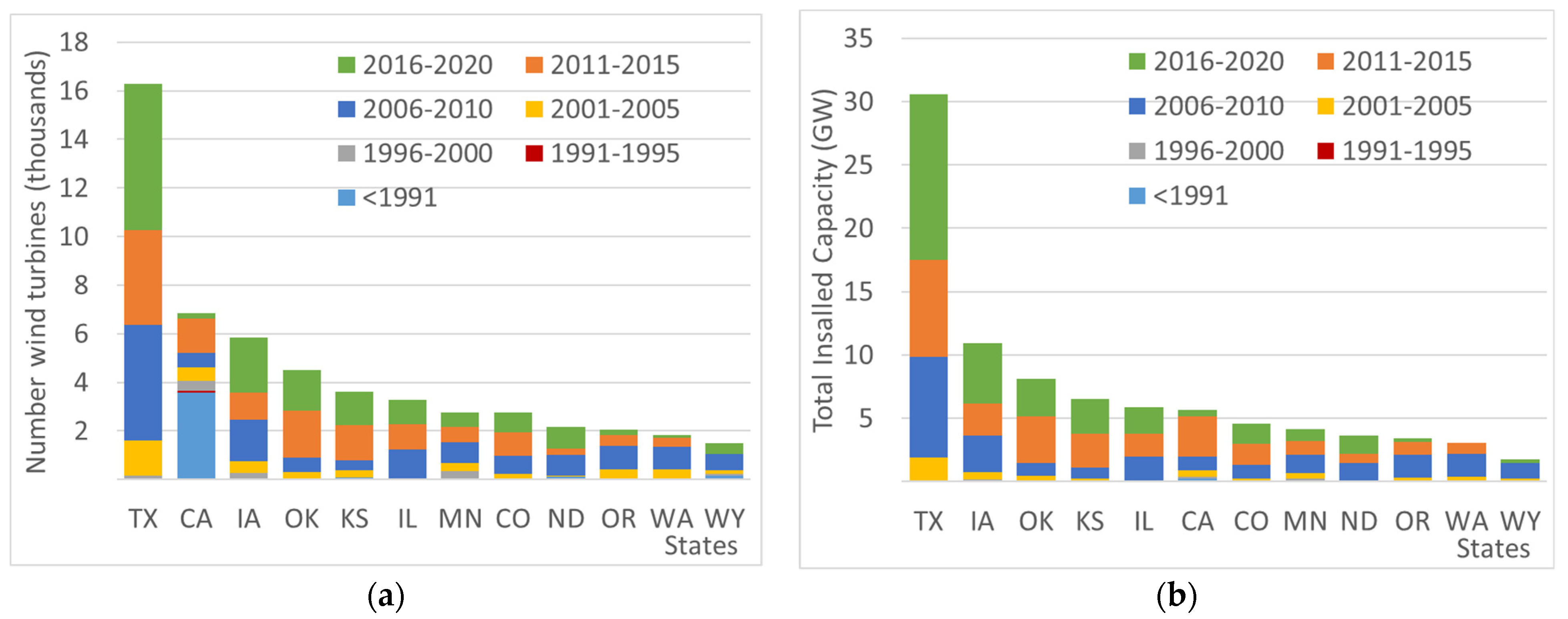
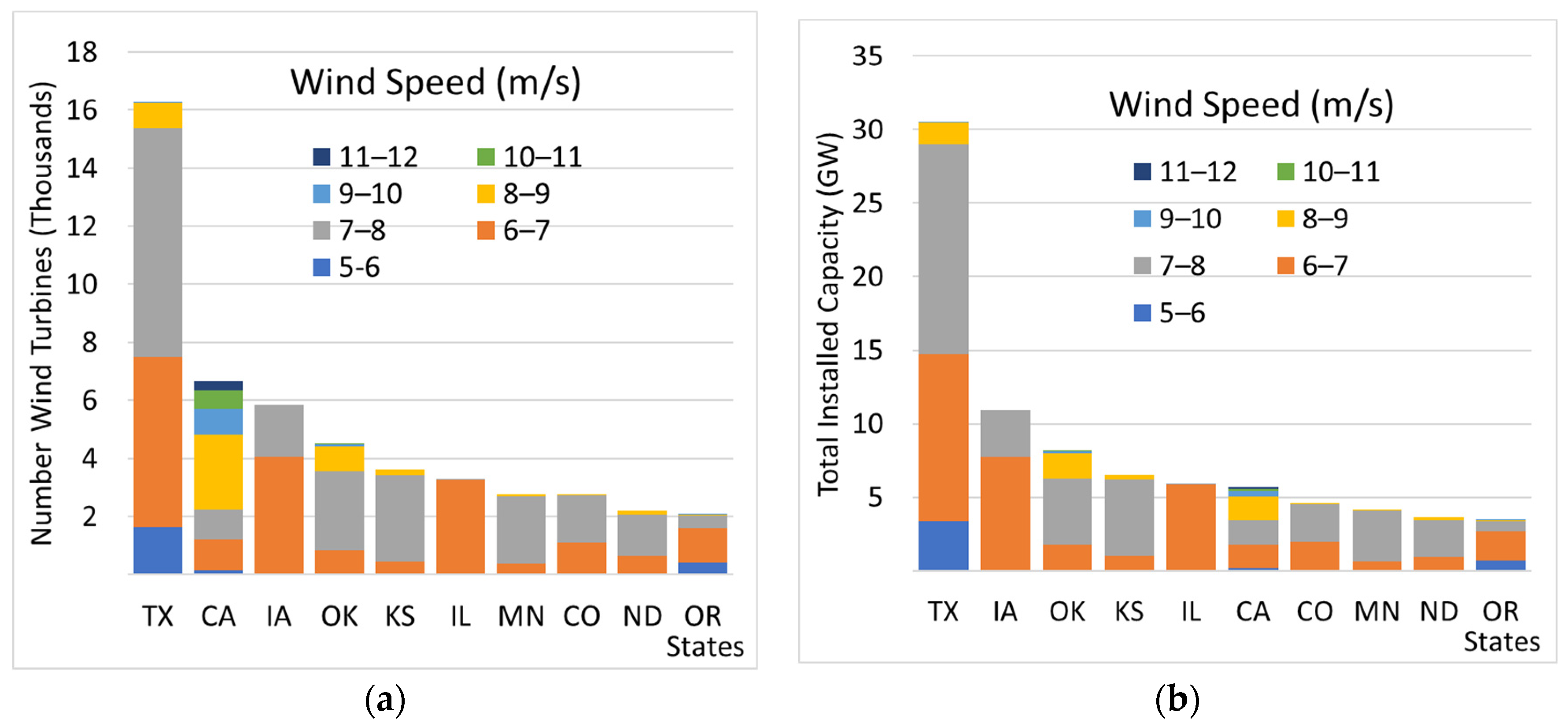
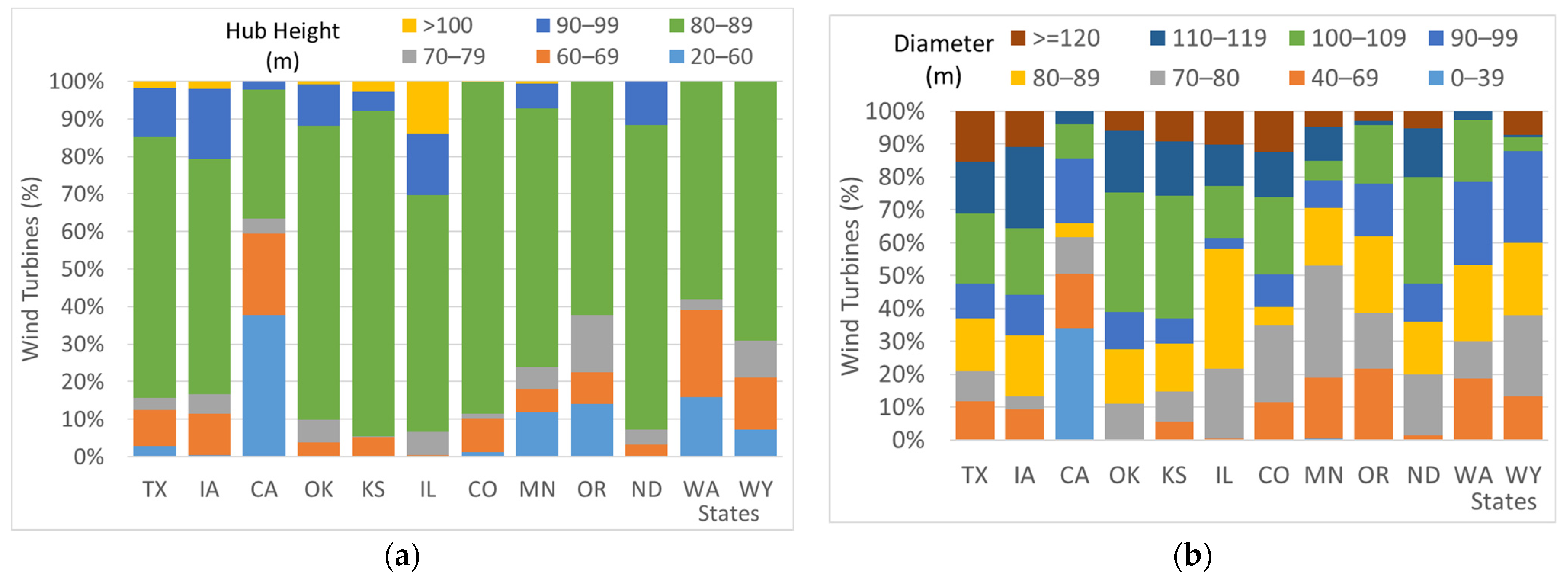


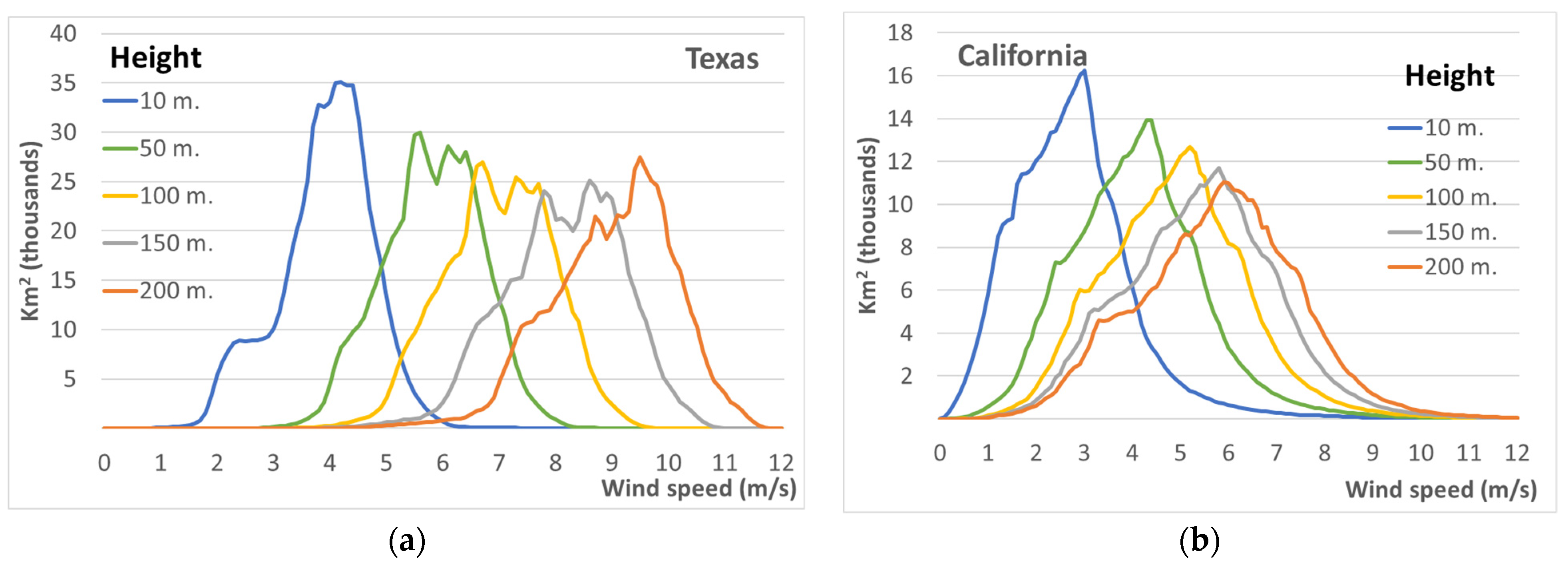
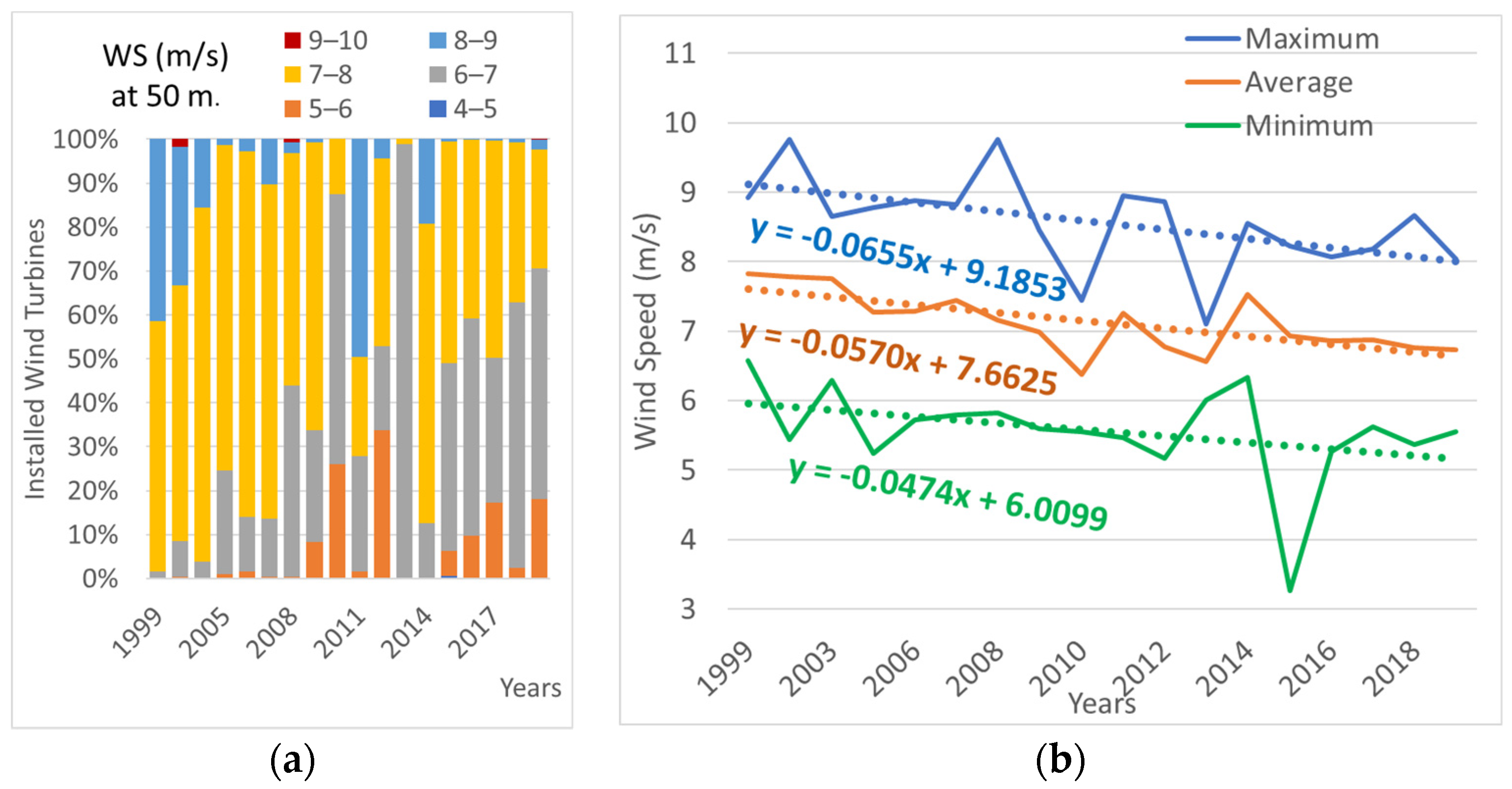
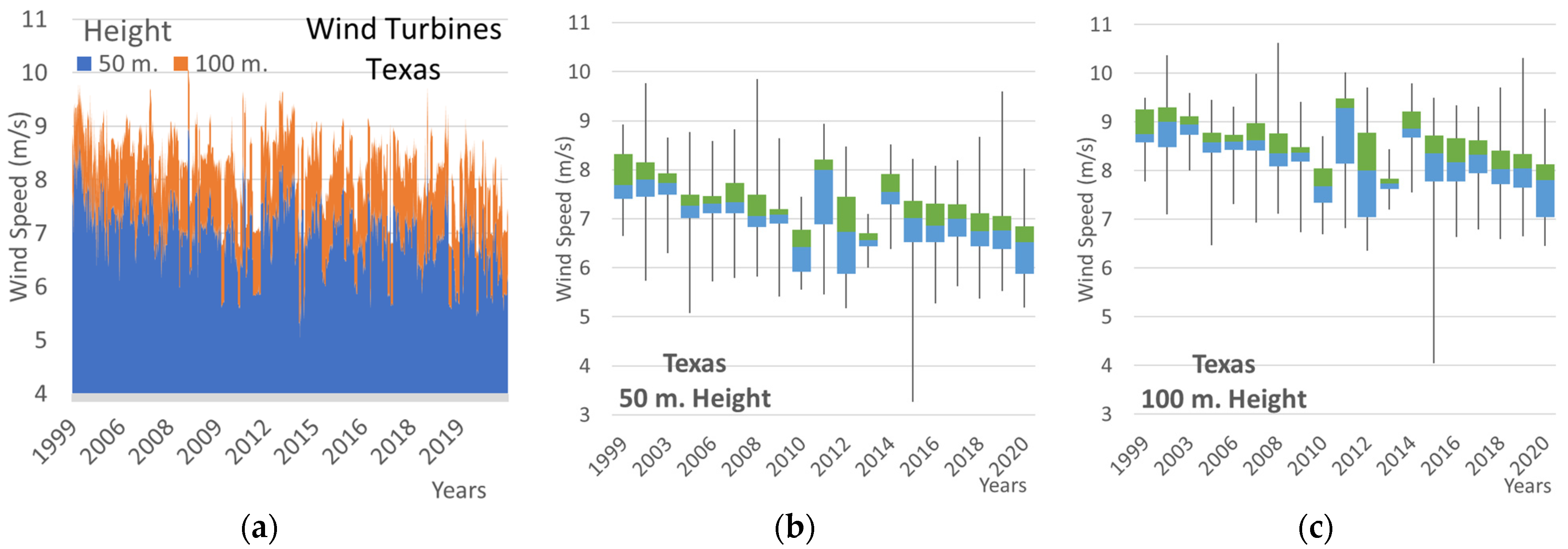
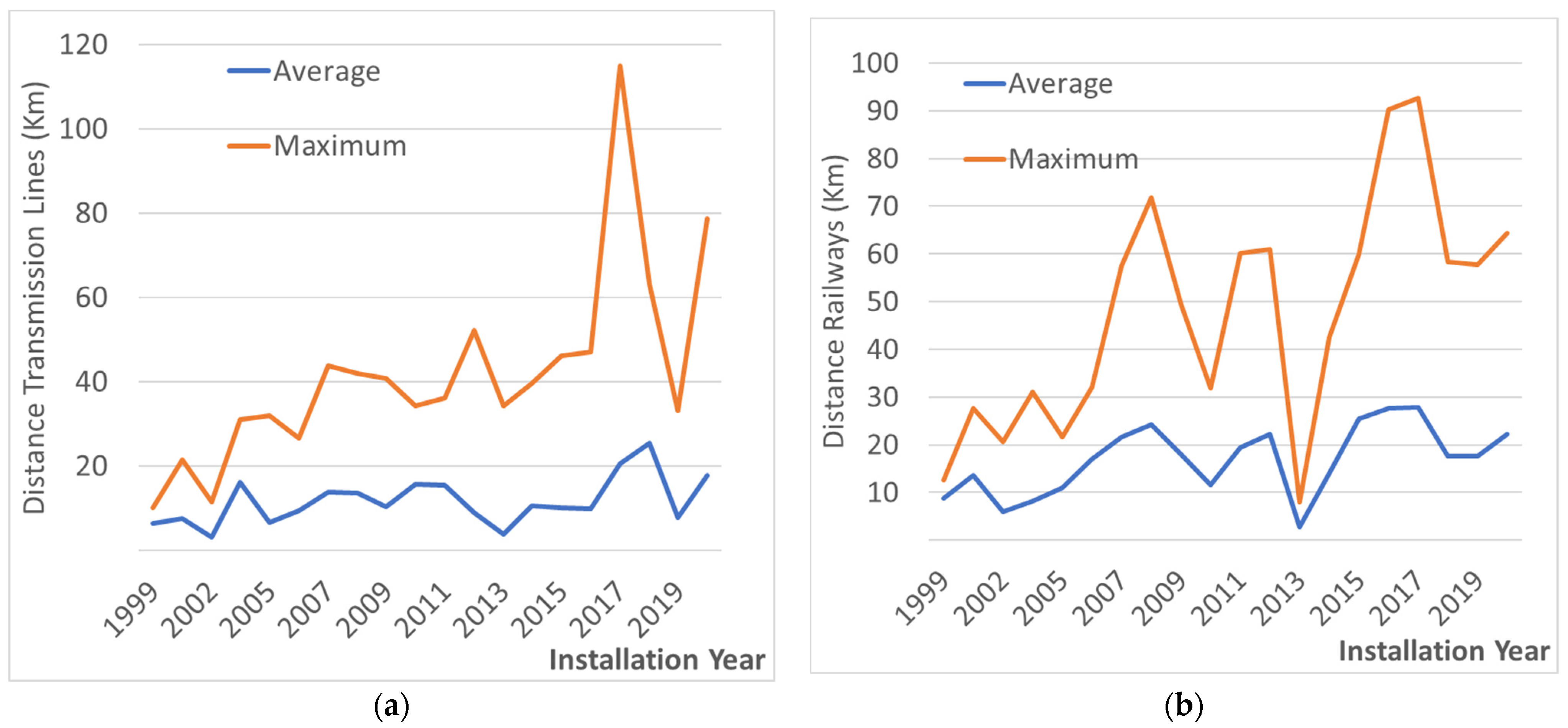


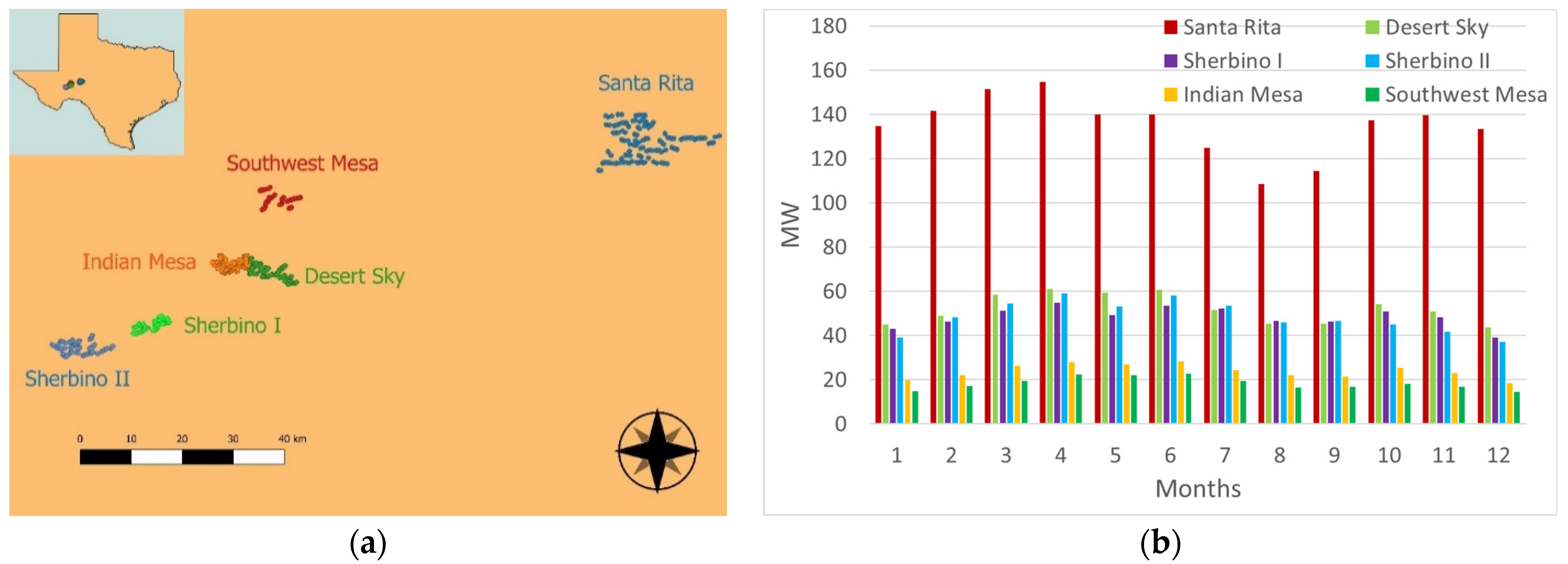

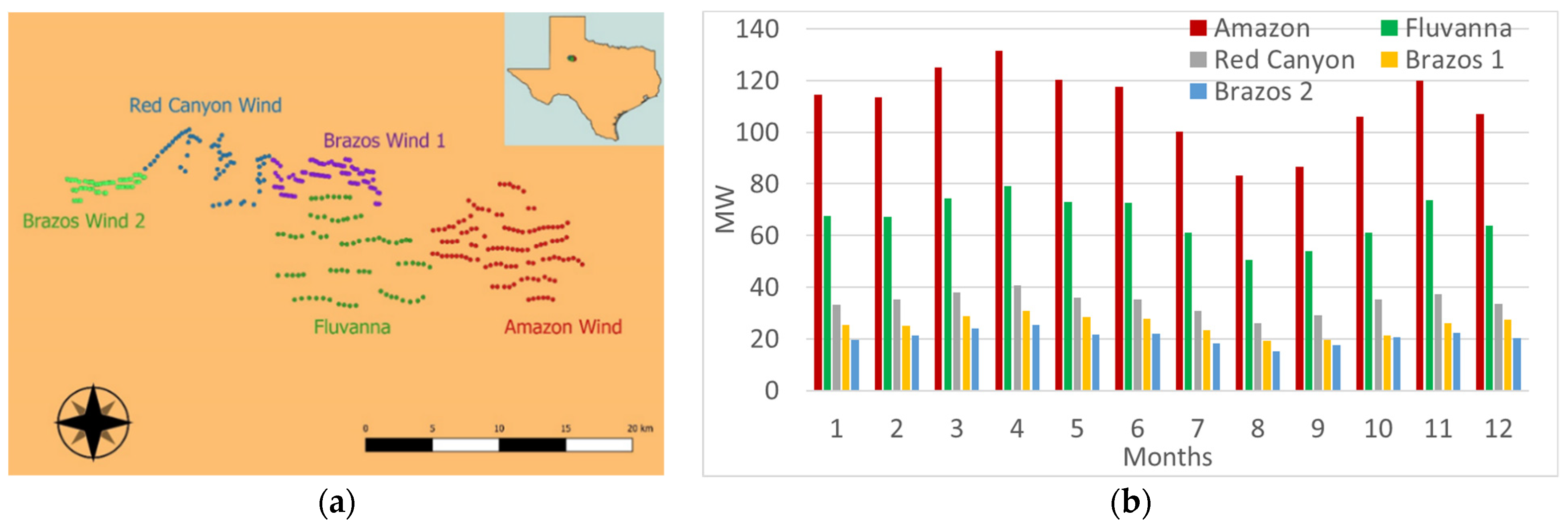

| Name | Year | No. of Turbines | Cap (MW) | Diameter (m) | Hub Height (m) | Wind Speed (m/s) | Wind Speed (m/s) |
|---|---|---|---|---|---|---|---|
| 50 m | 100 m | ||||||
| SW Mesa | 1999 | 114 | 80.2 | 48 | 50 | 8.012 | 8.939 |
| Desert Sky | 2001 | 105 | 143 | 70.5 | 65 | 8.231 | 9.253 |
| Indian Mesa | 2001 | 125 | 82.5 | 47 | 50 | 8.308 | 9.422 |
| Sherbino I | 2008 | 50 | 150 | 90 | 80 | 8.796 | 9.925 |
| Sherbino II | 2011 | 58 | 145 | 96 | 80 | 8.096 | 9.325 |
| Santa Rita | 2018 | 120 | 300 | 116 | 90 | 7.208 | 8.496 |
| Name | Transmission Line Distance (km) | Highway Distance (km) | Railway Distance (km) | ||||||
|---|---|---|---|---|---|---|---|---|---|
| Avg | Max | Min | Avg | Max | Min | Avg | Max | Min | |
| SW Mesa | 8.7 | 10.2 | 6.8 | 8.6 | 11.3 | 6.2 | 8.6 | 11.3 | 6.1 |
| Desert Sky | 7.9 | 9.2 | 5.3 | 3.0 | 5.5 | 1.2 | 24.2 | 27.6 | 20.9 |
| Indian Mesa | 3.1 | 4.9 | 0.7 | 5.4 | 7.4 | 3.2 | 20.7 | 22.6 | 17.9 |
| Sherbino I | 18.8 | 21.7 | 16.1 | 8.1 | 9.7 | 6.0 | 28.9 | 30.6 | 27.0 |
| Sherbino II | 30.7 | 34.0 | 26.3 | 10.3 | 12.2 | 7.9 | 30.3 | 33.0 | 27.5 |
| Santa Rita | 24.5 | 31.7 | 18.8 | 4.6 | 8.4 | 0.3 | 4.49 | 9.74 | 0.3 |
| Name | Year | No. of Turbines | Cap (MW) | Diameter (m) | Hub Height (m) | Wind Speed (m/s) | Wind Speed (m/s) |
|---|---|---|---|---|---|---|---|
| 50 m | 100 m | ||||||
| Brazos 1 | 2003 | 99 | 99 | 61.4 | 69 | 7.814 | 9.067 |
| Brazos 2 | 2003 | 61 | 61 | 61.4 | 60 | 7.635 | 8.694 |
| Red Canyon | 2006 | 56 | 84 | 77 | 80 | 7.768 | 8.817 |
| Fluvanna I | 2017 | 74 | 155.4 | 114 | 80 | 7.148 | 8.456 |
| Amazon | 2017 | 110 | 253 | 116 | 80 | 7.282 | 8.573 |
| Name | Transmission Line Distance (km) | Highway Distance (km) | Railway Distance (km) | ||||||
|---|---|---|---|---|---|---|---|---|---|
| Avg | Max | Min | Avg | Max | Min | Avg | Max | Min | |
| Brazos 1 | 11.8 | 16.0 | 7.7 | 3.5 | 6.8 | 0.9 | 3.4 | 6.7 | 0.9 |
| Brazos 2 | 27.7 | 31.1 | 14.3 | 14.5 | 17.4 | 4.9 | 14.5 | 17.6 | 4.8 |
| Red Canyon | 20.3 | 25.5 | 16.3 | 7.6 | 11.7 | 4.4 | 7.5 | 11.6 | 4.2 |
| Fluvanna I | 9.9 | 15.3 | 3.9 | 5.6 | 11.3 | 0.4 | 5.6 | 11.3 | 0.3 |
| Amazon | 2.0 | 4.5 | 0.2 | 4.5 | 9.3 | 0.4 | 4.6 | 9.4 | 0.5 |
Publisher’s Note: MDPI stays neutral with regard to jurisdictional claims in published maps and institutional affiliations. |
© 2021 by the author. Licensee MDPI, Basel, Switzerland. This article is an open access article distributed under the terms and conditions of the Creative Commons Attribution (CC BY) license (https://creativecommons.org/licenses/by/4.0/).
Share and Cite
Haces-Fernandez, F. Higher Wind: Highlighted Expansion Opportunities to Repower Wind Energy. Energies 2021, 14, 7716. https://doi.org/10.3390/en14227716
Haces-Fernandez F. Higher Wind: Highlighted Expansion Opportunities to Repower Wind Energy. Energies. 2021; 14(22):7716. https://doi.org/10.3390/en14227716
Chicago/Turabian StyleHaces-Fernandez, Francisco. 2021. "Higher Wind: Highlighted Expansion Opportunities to Repower Wind Energy" Energies 14, no. 22: 7716. https://doi.org/10.3390/en14227716
APA StyleHaces-Fernandez, F. (2021). Higher Wind: Highlighted Expansion Opportunities to Repower Wind Energy. Energies, 14(22), 7716. https://doi.org/10.3390/en14227716







